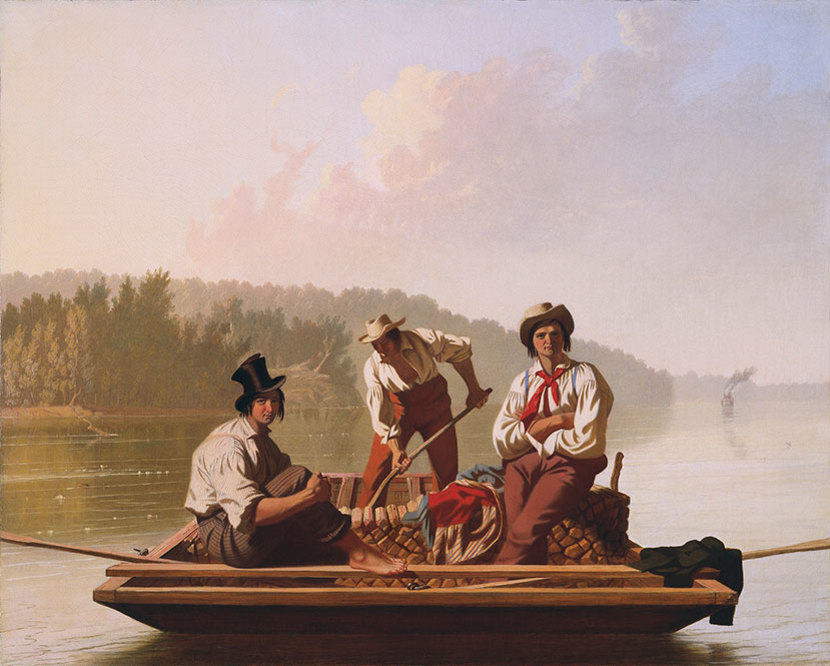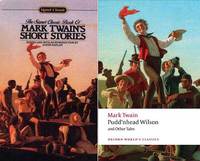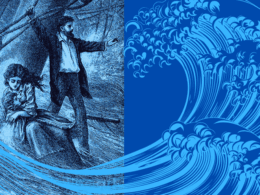Now on view at the Metropolitan Museum of Art in New York City, the exhibition Navigating the West: George Caleb Bingham and the River brings together sixteen iconic paintings by George Caleb Bingham (1811-1879) depicting life on the Mississippi and Missouri rivers before the Civil War. A Virginia native who moved to the Missouri Territory as a young boy, Bingham was a primarily self-taught artist who found his truest subject in the mid-1840s with narrative scenes representing what was then the Western frontier of the United States.

Bingham’s serene, sunlit vistas form a captivating portrayal of river life in the decades prior to the Civil War. Library of America readers may find these paintings especially appealing, though, as a visual analog to several canonical works by Bingham’s contemporary and fellow Missourian Mark Twain: The Adventures of Tom Sawyer, Life on the Mississippi, The Adventures of Huckleberry Finn, and Pudd’nhead Wilson (all of which are collected in the Library of America volume Mark Twain: Mississippi Writings).
Twain, of course, grew up on the Mississippi in the same era in which Bingham was painting it and he became a cub riverboat pilot in 1857—the year of Jolly Flatboatmen in Port, one of the last major works in Navigating the West. Yet the differences between the two Missourians tell us more about their respective artistic temperaments than any surface affinities. Bingham’s idealizing tendencies are evident both in his tranquil landscapes (there are no turbulent waters in these river scenes) and in the meticulously posed and lit human figures in his paintings. Moreover, as the wall text accompanying the Met exhibition suggests, his art reflected the aspirations of a citizenry looking to be reassured that civilization had indeed come to the frontier.
It might be fair to say Bingham’s Mississippi has more in common with the boyhood idyll of Tom Sawyer than the more brutal world of Huckleberry Finn. And in 1883, looking back on antebellum river society in Life on the Mississippi, Twain evokes a more unruly, volatile milieu than anything we see in Bingham’s canvases—one populated by “hordes of rough and hardy men,”
rude, uneducated, brave, suffering terrific hardships with sailor-like stoicism; heavy drinkers, coarse frolickers in moral sties like the Natchez-under-the-hill of that day, heavy fighters, reckless fellows, every one, elephantinely jolly, foul-witted, profane; prodigal of their money, bankrupt at the end of the trip, fond of barbaric finery, prodigious braggarts; yet, in the main, honest, trustworthy, faithful to promises and duty, and often picturesquely magnanimous.

That chapter in Life on the Mississippi continues with an account of a showdown between two river men marked by memorable braggadocio; the combatants’ characteristic boasts include “I’m the old original iron-jawed, brass-mounted, copper-bellied corpse-maker from the wilds of Arkansaw!” and “When I’m playful I use the meridians of longitude and parallels of latitude for a seine, and drag the Atlantic Ocean for whales!” Readers might reasonably conclude that, just as Bingham’s impulse was to tame his subjects for the broader public, Twain’s gifts led him in the opposite direction.
Navigating the West: George Caleb Bingham and the River is on view at the Metropolitan Museum of Art in New York City through September 20, 2015. Visit metmuseum.org for complete exhibition information.



